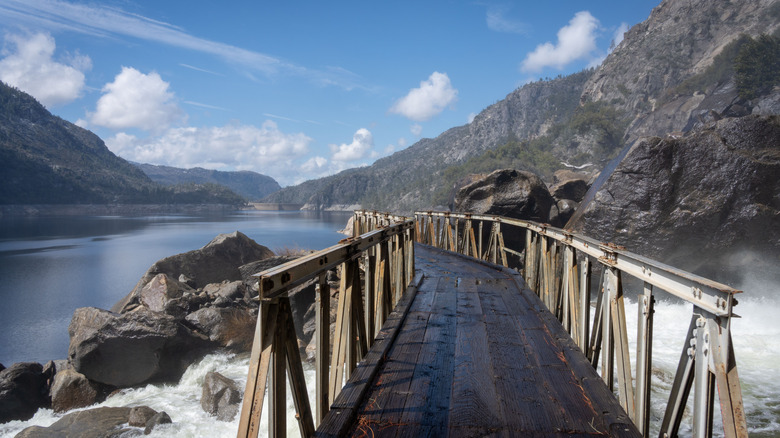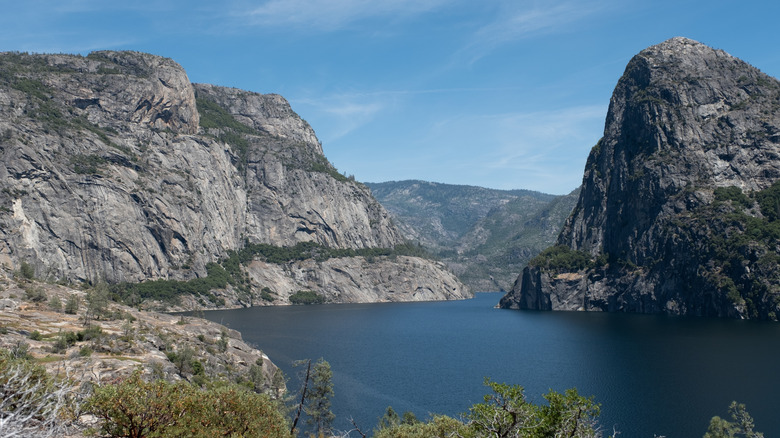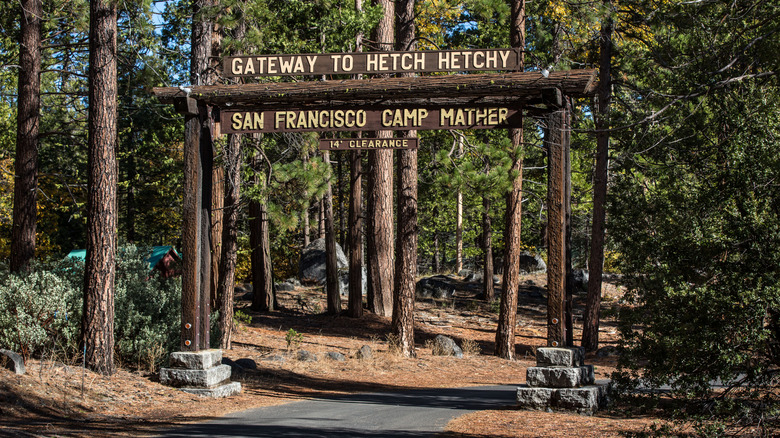'Yosemite's Secret Valley' Is A Beautiful Wonder With Soaring Granite Domes, Waterfalls, And Scenic Vistas
To many visitors, Yosemite National Park really means Yosemite Valley, the park's most famous area. But far from Yosemite Valley's glut of RVs and tour buses sits an expanse of preserved wilderness that legendary outdoorsman John Muir once called, "a grand landscape garden, one of Nature's rarest and most precious mountain temples," (via Yosemite Mariposa Country). This largely unknown section of the park gets a mere 1% of the traffic of Yosemite Valley and has been appropriately dubbed "Yosemite's Secret Valley" by the intrepid trekkers of Sidetrack Adventures. It's also got a comical name that's fun to say: Hetch Hetchy.
Hetch Hetchy has everything you'd want from a trip to Yosemite: hiking, camping, fishing, lakes, rivers, cascading waterfalls, and stunning views — plus, an expanse of ruggedly gorgeous granite domes and the massive reservoir after which the area gets its name. The only thing you're really missing by visiting Hetch Hetchy instead of Yosemite Valley is the headache of dealing with too many people while trying to escape to a remote, natural wonderland. Although you won't get to do signature treks like Yosemite Valley's famed, high-elevation Half Dome hike or climb the vertical face of El Capitan, one of the most dangerous in America, there's plenty to explore in this lesser-known region.
Hetch Hetchy offers a network of pristine and peaceful trails that offer views of prominent domes like Hetch Hetchy Dome, walk-bys of beautiful waterfalls like Wapama Falls, strolls by tranquil rivers like Laurel Lake, and even sojourns on wooden walkways along the reservoir to take in the sights from a different, lower angle. You also won't get crushed by the human swarm that hangs around Firefall observation area in late Februrary.
Granite domes, beautiful waterfalls, and pristine trails in Hetch Hetchy
When setting out into Hetch Hetchy, it makes sense to use its waterfalls, domes, and lakes as destinations or stopovers along its webwork of trails. But no matter which route you take, you can sample everything Hetch Hetchy has to offer.
On the north side of the Hetch Hetchy Reservoir, you'll find Tueeulula and Wapama Falls. The scenery along the way is lovely (and not full of people), and the picture-worthy vistas are worth the trip. Go a little past Wapama Falls and you'll reach the base of the iconic Hetch Hetchy Dome (pictured). Go a little farther to reach Rancheria Falls. The Wapama Falls in-and-out path is less than 5 miles long and moderately difficult with some rough terrain, or you can head north of the reservoir to try the full Lake Vernon route, which is about 20 miles long and reaches a challenging elevation of over 4,000 feet.
That's just one hiking option when visiting Hetch Hetchy. Folks interested in higher vistas can wind their way to the 8,356-foot Mount Gibson in the north or Smith Peak in the south, both of which afford eagle-eyed views of Hetch Hetchy's landscape and domes. Kolana Rock is visible at various points across the reservoir from Hetch Hetchy Dome. It's also is a peregrine falcon breeding ground, so birdwatchers take note.
Accessing and staying within Hetch Hetchy
While natural terrain heeds no borders, Hetch Hetchy does. There's one entrance to go in and out of Hetch Hetchy, accessible via Route 120, east of San Francisco and about an hour from Yosemite Valley. Route 120 will take you to the Big Oak Flat Entrance, which puts you on Evergreen Road and transforms into Hetch Hetchy Road at the Camp Mather General Store — an ideal pit stop before venturing farther. Follow Hetch Hetchy Road north to the area's entrance gate and parking, where it's $35 per four-wheel vehicle, $30 for a motorcycle, or $20 for you and your feet, horse, bus, and/or bicycle. Visitors should bear in mind that Hetch Hetchy is only open during daylight and should arrive as early as possible. Also, road closures do happen and are available on the National Park Service's website.
Once you've arrived at Hetch Hetchy, we could blithely say, "Start walking." That's fine if you're there just for the day, but if you want to stay overnight, you'll need to wade into Yosemite's ever-fun tangle of camping permits. You can self-issue a permit from November to April, but you need approval from May to October. The limited permits are split between Beehive Meadow and Rancheria Falls, and it's important to plan in advance. Many sites are available 24 weeks out, while the rest are open within a day of booking. Barring such typical overnight options, there's actually a big cabin called San Francisco's Chalet that requires pre-registration and comes with no guarantee of being approved. It's best to pack the camping gear and be prepared for anything.


